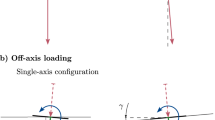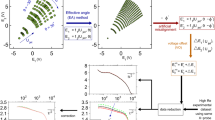Abstract
An inverse problem is used to significantly improve the frequency response of a three-segment electrodiffusion (ED) sensor subjected to strong inertial effects in high-amplitude unsteady flows. It is shown that the fluctuating component of the wall shear rate’s magnitude and direction can be accurately determined when both variables exhibit simultaneous large-amplitude variations, even when using an uncalibrated probe. Measurements are performed in the vicinity of a rotating cylinder in motion in a highly viscous fluid with poor electrochemical diffusivity, thus establishing a harsh environment for an ED sensor. Results using the inverse problem showed strong concordance with PIV complementary measurements in most cases and further expose the potential of this non-intrusive technique for thorough wall shear stress diagnostics.
Graphical Abstract












Similar content being viewed by others
Notes
One can show that \(k^*=\sum {\textit{Sh}}^*_{\text {num},\,m}\) when \({\textit{Pe}}\rightarrow \infty\), but \(k^*\) can vary when dealing with experimental signals (cf. Sect. 2.2).
While no simulation was performed for the OC motion, one can expect similar conclusions as velocities and frequencies are comparable, except for case OC2.
Based on errors of \(\sim 2\%\) and \(\sim 3\%\) on A and D, respectively (cf. Sect. 2.1).
Such a motion could be achieved by disabling smoothing parameters in the motor drive.
References
Arvia AJ, Marchiano SL, Podesta JJ (1967) The diffusion of ferrocyanide and ferricyanide ions in aqueous solutions of potassium hydroxide. Electrochim Acta 12(3):259–266
Bard AJ, Faulkner LR (2001) Electrochemical methods: fundamentals and applications, 2nd edn. Wiley, Hoboken
Berger FP, Ziai A (1983) Optimisation of experimental conditions for electrochemical mass transfer measurements. Chem Eng Res Des 61(6):377–382
Deslouis C, Tribollet B, Tihon J (2004) Near-wall turbulence in drag reducing flows investigated by the photolithography-electrochemical probes. J Non-Newtonian Fluid Mech 123(2):141–150
Fourrié G, Keirsbulck L, Labraga L (2013) Wall shear stress characterization of a 3d bluff-body separated flow. J Fluids Struct 42:55–69
Hanratty TJ, Campbell JA (1996) Measurement of wall shear stress. In: Goldstein R (ed) Fluid mechanics measurements, 2nd edn. Taylor & Francis, Hoboken, pp 575–648
He S, Ariyaratne C, Vardy AE (2011) Wall shear stress in accelerating turbulent pipe flow. J Fluid Mech 685:440–460
Jordan J, Ackerman E, Berger RL (1956) Polarographic diffusion coefficients of oxygen defined by activity gradients in viscous media. J Am Chem Soc 78(13):2979–2983
Labraga L, Bourabaa N, Berkah T (2002) Wall shear stress from a rotating cylinder in cross flow using the electrochemical technique. Exp Fluids 33(3):488–496
Lamarche-Gagnon MÉ (2018) Développement de la méthode électrodiffusionnelle pour la mesure instantanée des deux composantes du frottement pariétal. PhD thesis, Polytechnique Montréal (Canada)
Lamarche-Gagnon MÉ, Vétel J (2018) An inverse problem to assess the two-component unsteady wall shear rate. Int J Therm Sci 130:278–288
Mao ZX, Hanratty TJ (1991a) Analysis of wall shear stress probes in large amplitude unsteady flows. Int J Heat Mass Transfer 34(1):281–290
Mao ZX, Hanratty TJ (1991b) Application of an inverse mass transfer method to the measurement of turbulent fluctuations in the velocity gradient at the wall. Exp Fluids 11(1):65–73
Mao ZX, Hanratty TJ (1992) Measurement of wall shear rate in large amplitude unsteady reversing flows. Exp Fluids 12(4):342–350
Maquinghen T (1999) Métrologie tridimensionnelle instationnaire à l’aide de la méthode polarographique. PhD thesis, Valenciennes
Naughton JW, Sheplak M (2002) Modern developments in shear-stress measurement. Prog Aerosp Sci 38(6):515–570
Ozisik MN (2000) Inverse heat transfer: fundamentals and applications. CRC Press, Routeledge
Pauli J, Sobolik V, Onken U (1991) Oxygen as depolarizer in electrodiffusion diagnostics of flow. Chem Eng Sci 46(12):3302–3304
Rehimi F, Aloui F, Nasrallah SB, Doubliez L, Legrand J (2006) Inverse method for electrodiffusional diagnostics of flows. Int J Heat Mass Transfer 49(7):1242–1254
Reiss LP, Hanratty TJ (1963) An experimental study of the unsteady nature of the viscous sublayer. AlChE J 9(2):154–160
Schlichting H, Gersten K (2000) Boundary-layer theory. Springer, Berlin
Selman JR, Tobias CW (1978) Mass-transfer measurements by the limiting-current technique. Adv Chem Eng 10:211–318
Sobolík V, Wein O, Čermák J (1987) Simultaneous measurement of film thickness and wall shear stress in wavy flow of non-newtonian liquids. Collect Czech Chem Commun 52(4):913–928
Sobolík V, Tihon J, Wein O, Wichterle K (1998) Calibration of electrodiffusion friction probes using a voltage-step transient. J Appl Electrochem 28(3):329–335
Tihon J (2014) Application of the electrodiffusion method for near-wall flow diagnostics. EPJ Web Conf 67:2117
Wein O, Sobolík V (1987) Theory of direction sensitive probes for electrodiffusion measurement of wall velocity gradients. Collect Czech Chem Commun 52(9):2169–2180
Acknowledgements
The authors would like to acknowledge the financial support of the Canadian Foundation for Innovation (CFI), the Natural Sciences and Engineering Research Council of Canada (NSERC) and the Fonds de recherche du Québec—Nature et technologies (FRQNT). We also acknowledge the technical support of T. Lafrance from MËKANIC and J.-M. Béland for their cooperation in the design and fabrication of the experimental setup and the reviewers for valuable recommendations in the revision process.
Author information
Authors and Affiliations
Corresponding author
Additional information
Publisher's Note
Springer Nature remains neutral with regard to jurisdictional claims in published maps and institutional affiliations.
Electronic supplementary material
Below is the link to the electronic supplementary material.
Rights and permissions
About this article
Cite this article
Lamarche-Gagnon, MÉ., Sobolík, V. & Vétel, J. Diagnostics of the fluctuating wall shear rate components using an uncalibrated three-segment electrodiffusion sensor. Exp Fluids 59, 168 (2018). https://doi.org/10.1007/s00348-018-2623-z
Received:
Revised:
Accepted:
Published:
DOI: https://doi.org/10.1007/s00348-018-2623-z




